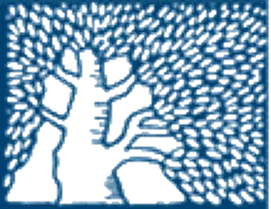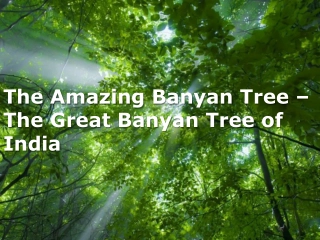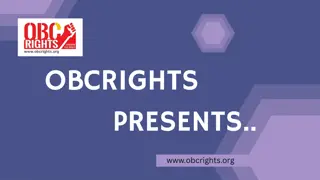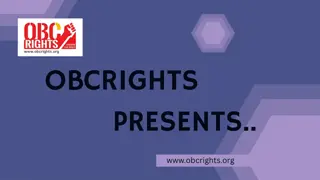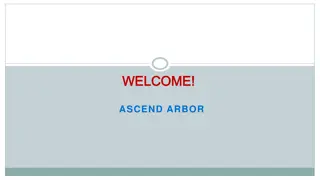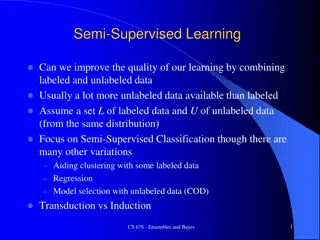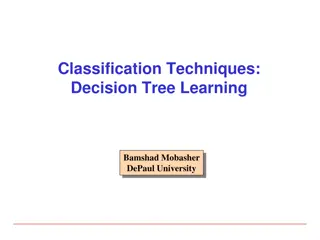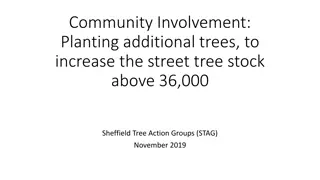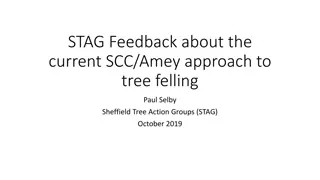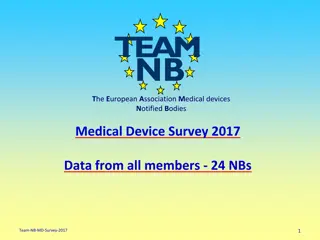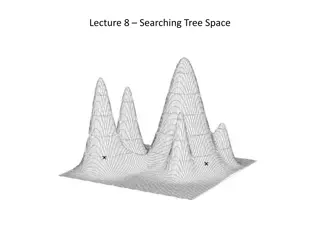Unlabeled Certificates in Decision Tree Model
Dive into the concept of unlabeled certificates in the decision tree model, exploring their significance in minimizing queries to adjacency matrices for graph properties. Learn about the difference between labeled and unlabeled certificates, their relevance in invariant functions, and the complexities associated with decision trees. Discover how hints in the form of isomorphic copies impact query efficiency and correctness in graph analysis scenarios.
Download Presentation

Please find below an Image/Link to download the presentation.
The content on the website is provided AS IS for your information and personal use only. It may not be sold, licensed, or shared on other websites without obtaining consent from the author.If you encounter any issues during the download, it is possible that the publisher has removed the file from their server.
You are allowed to download the files provided on this website for personal or commercial use, subject to the condition that they are used lawfully. All files are the property of their respective owners.
The content on the website is provided AS IS for your information and personal use only. It may not be sold, licensed, or shared on other websites without obtaining consent from the author.
E N D
Presentation Transcript
INSTANCE COMPLEXITY AND UNLABELED CERTIFICATES IN THE DECISION TREE MODEL Tomer Grossman Ilan Komargodski Moni Naor WeizmannInstitute NTT Huji WeizmannInstitute IRIF, Paris, Jan 23rd 2020 Algorithms and Discrete Structures Seminar
UNLABELED CERTIFICATES: WHAT ARE THEY GOOD FOR? Want to check whether a graph satisfies some (graph) property Given as an untrusted hint an isomorphic copy of the graph. The goal is to minimize the number queries to the adjacency matrix Are such hints helpful? In the worst case? Per instance? Want correctness even if the hint is wrong Tested for efficiency only if the hint is correct Where do the hints come from? Represent knowledge of the structure of the graph, e.g. social network
EXAMPLE: IS THERE AT LEAST ONE EDGE? ? The input graph The hint
THE DECISION TREE MODEL Labels on the leaves: value of function Graph ? on ? vertices and a graph property ?:? {0,1} Graph ? is given via an adjacency matrix. Queries to entries Each query of the form: Do vertices ? and? have an edge between them? An algorithm can be thought of as a binary tree Should be correct on all inputs Tree T Want a shallow tree fewer queries. ?(?,?) - depth of tree T on input ? ? 0,1? ?(?,x) Worst case complexity of T: max
Example: f = there is an isolated node ? ? = ? LABELED CERTIFICATES 2 But C ? = n-1 ?(?,?) - depth of tree T on input ? Let ? be the set of correct decision trees for f Deterministic decision tree complexity ? 0,1? ?(?,x) ? ? = min ? ? max Among those that are always correct This is tight: ?(?) ?(?)2always Labeled Certificate: number of queries best tree makes on input x. ?(f, x) = min ? ??(?,x) The worst-case certificate complexity ? f = max ? 0,1? ? f, x
UNLABELED CERTIFICATES Especially relevant: when the function is invariant under a family of permutations Labeled certificate: a guess to the true input. An Unlabeled certificate: a guess to an isomorphic copy of the true input. Unlabeled Certificate: The number of queries an algorithm (that is always correct) makes on an input isomorphic to the certificate. ??(f, x) = min ? ?max The worst-case unlabeled certificate complexity ?? f = max ? ??(?, (x)) For f= there is an isolated node ?? ? (?2) ? 0,1??? f, x But C ? = n-1 ?(?) ??(?) ?(?)
DO UNLABELED CERTIFICATES EVER HELP INTHEWORST CASE? Do unlabeled Certificates help in the worst case for some function? YES!!! Unlabeled Certificates may help as much as labeled certificates Theorem: There exists a function ? with ??(?) ?(? log ?)while ?(?) (?2) Do not know any simple function! Monotone?
THE CONSTRUCTION Function is 1 iff a bunch of conditions are met First level: the ????? function The Crowd: all vertices must have degree at least log n among themselves Theorem: for the function ????? we have ?(?????) ?(? log ?) ?(?????) (?2) ??(?????) (?2) Goal: turn the unlabeled certificate into an effectively labeled one for the crowd.
Gives direction. Breaks symmetry THE CONSTRUCTION Graph has a binary tree with O(log?) leaves where each right child has an intermediate child P P P log log n Additional condition: No two vertices in the Crowd have the sameneighborhood when restricted to the leaves of the tree The Crowd: all vertices must have degree at least log n among themselves
THE CONSTRUCTION Add two additional nodes T1 and T2 connected just to P Add node B connected to all nodes, except T1 and T2. T1 T2 P B log log n Additional condition: No leaf has degree five or less. No two vertices in the Crowd should have same neighborhood in the leaves Special nodes: degree 1, 2, 5 and n-3 The Crowd: all vertices must have degree at least log n among themselves
Best, van Emde Boas Lenstra THE ALGORITHMWITHTHE UNLABELED CERTIFICATE T1 T2 P First phase: find either T1, T2orB Afterwards: in O(n) queries, also find P. Idea: scorpion graph Pick arbitrary vertex u and query all of its neighbors. If deg(u) {1, 5, n 3}: done! As umust be T, P (or one of P s immediate children) or B respectively. Assume deg(u) not {1, 5, n 3, n 2, n 1}. Let N0 be the set of u s neighbors and N1 the set of non-neighbors. Claim: B N0 and T1, T2 N1. FurthermoreP N1 Since all of P s neighbors have degree 1, 5 or n 3. B N0 u N1
Do not need the certificate! Candidates for T1 or T2 Candidates for B THE ALGORITHM: FINDING P u Pick arbitrary vertex u Assume deg(u) {1,5,n-3} If (v1, v2) is an edge: v2cannot be T1 or T2 If (v1, v2) is not an edge: v1cannot be B T1 T2 B T1 P B T2 P No two vertices in the Crowd have same neighborhood in the leaves v1 ? v2 The Crowd: all vertices must have degree at least log n among themselves N0 N1
THE CONSTRUCTION: FINDINGTHE MAPPING After finding P: full tree can be recovered. P Given the leaves: can find the mapping between nodes in the crowd and the nodes in the graph. Can check the min degree. log log n Total: Finding P: O(n) queries Finding the tree: O(n log n) queries Finding the mapping O(n log n) queries
WORST CASE ANALYSISOF ALGORITHMS Worst case analysis of algorithms is the hallmark of theoretical computer science For a given algorithm A find an input D on which A has the worst performance Evaluate the algorithm based on this value But is it meaningful? Yes sometimes! Prefer algorithms with small worst case value Lots of nice properties: Composition When the input is adversarially chosen When we want to have a fixed upper bound on the complexity: hardware, timing attacks
SOME KNOWN PROPERTIESOF DECISION TREE COMPLEXITY Randomized Complexity R(f) : distribution on decision trees Correct on all inputs with probability at least 2/3 s(f) Sensitivity bs(f) Block sensitivity RC(f) C(f) D(f) n andRC(f) R(f) D(f). C(f) s(f) bs(f) D(f) s(f) bs(f)2 bs(f)3 bs(f) s(f)4 D(f) C(f)2 bs(f) 3RC(f) For every monotone Boolean function f: C(f) = s(f) = bs(f) Extensively studied Unconditional lower bounds Useful step for lower bounds in other models( lifting ) Major findings: polynomial relations between notions Exact relationships still open
WORST CASEVS. INSTANCEBY INSTANCE But, in some cases worst case is not very informative: if worst-case is bad all algorithms look the same. Instead: consider Instance Optimality Compare two algorithms A and B input by input Say that algorithm A weakly dominates B if for no input does A perform (much) worse than B 16
INSTANCE OPTIMALITYOF DECISION TREES Letf: {0,1}n {0,1} Intuition: want to compare complexity of f on each input to the best possible algorithm per input Deterministic Randomized Unlabeled Are there IO functions? Unlabeled certificates Characterizations Deterministic vs. Randomized IO Terminology: Algorithm or decision tree is instance optimal Function is instance optimizable
INSTANCE OPTIMALITYOF DECISION TREES Two Instance Optimizable functions: All certificates are of size n Parityf(x1, x2, , xn) = ?=1 ximod 2 ? Addressf(i, x1, x2, , xn) = xi 1 i n log n bits There is always a certificate of size 1+log n And none smaller
INSTANCE OPTIMALITYOF DECISION TREES Instance optimal deterministic and randomized are incomparable! There are functions that are one but not the other The saga of majority: very sensitive to the model Deterministic Randomized Unlabeled bits Unlabeled graphs Bounded error ? ? = min max ? 0,1?? ? ?[?(?,?)] Permutation group changes: edges vs. nodes Is IO preserved under Composition?
MAJORITYISNOT RANDOMIZED IO VS. LABELED CERTIFICATES x 1 0 1 0 1 0 1 1 0 1 Consider the distributions: W.P random x with weight ? 2+ ? 1 0 1 0 1 0 1 1 0 0 Hint W.P random x with weight ? 2 ? To distinguish with constant advantage: an ignorant algorithm must make (?) queries An algorithm that gets Hintas certificate: Makes ? ? random queries to x and verifies consistency with the certificate If more than ?changes were made: notice whp Conclude that actual input is close enough to x
MAJORITYIS (ALMOST) UNLABELED IO There is an algorithm for Majority s.t. on any input its complexity is larger by a factor of at most loglog ? of the one that gets the Hamming weight of the input as an unlabeled certificate. Idea: For an input of Hamming weight ? queries (given the weight as untrusted hint). Without a certificate: can estimate ? and then decide to stop or not. 1 ?2 2 ??, deciding majority takes Try ? =1 2,1 4 1 2? 1 ?2 loglog1 Takes ? queries Sequential hypothesis testing [Daskalakis-Kawase17] 1 To avoid stopping too early: reduce probability of error to log ?
MAJORITYASA GRAPH PROPERTYISNOT UNLABELED IO Deciding whether there are more edges than non-edges may be (much!) easier given a permutation of the graph than without it. There is a distribution on graphs where getting the unlabeled version enables O ? log ?queries and without it ?2 Idea: The distribution is a random graph with ? Without any additional information: ?2 queries are required to distinguish the +? case from the ? one. Similar to the plain majority Claim: Knowing a permutation of the graph: can completely reconstruct the graph with O ? log ?queries w.h.p. distinguish + ? case from the ? 2/2 ? edges.
MAJORITYASA GRAPH PROPERTYISNOT UNLABELED IO Sample? log ? nodes - the anchor Query all edges on a complete subgraph of size ? log ? Claim: w.h.p. there is a unique subgraph in G isomorphic to the anchor counting subgraphs Graph G
MAJORITYASA GRAPH PROPERTYISNOT UNLABELED IO Query all edges on a complete subgraph of size ? log ? - the anchor Claim:w.h.p. there is a unique subgraph in G isomorphic to the anchor For each other vertex:query all adjacent edges to the anchor Claim:w.h.p each vertex is uniquely connected to the anchor (random graph + union bound) Graph G
Until an edge is found: unlabeled certificate useless ATLEASTONEEDGE IS UNLABELED IO The optimal algorithm is: sample edge slots at random until an edge is found. If there are ? edges, takes 2/?queries in expectation Claim: For any graph with ? edges, any algorithm takes For any m edges graph G, the best algorithm with q queries can be thought of as the graph Hq of queries made as long as no edge was found. What are the chances that Hq and a random copy of G intersect? ? ? 2/?queries. Ifq ? 2/5?queries made, won t hit an edge with probability 4/5!
FUNCTION COMPOSITION Composition:? ?. Each bit of f is determined by g evaluated on n independent bits. Most query complexity measures compose. Is the composition of two instance optimal functions Instance optimal?
INSTANCE OPTIMALITY DOESNOTCOMPOSE ?(?) = (?1,?1),(?2,?2),...,(??,??) ? outputs ??where ? is the smallest value for which ??= 1. ?(?) is (strictly) instance optimal: any algorithm must read either ??or ??for each element in the 0 prefix.
INSTANCE OPTIMALITY DOESNOTCOMPOSE Observation: Computing ? can take anywhere between 1 and n queries. The input: ? ? = [(0,0),(0,0),...,(0,0),(1,0),(0,0),...,(0,0),(1,1) f((0,0),(0,0) (1,0)) f((1,0), f((0,0),(0,0) (1,1)) The number of queries required to compute each bit is: (?,1),(?,1),...,(?,1),(1,1) An algorithm with a certificate can query each of the ??and a single??for a total of O(n) queries. Any algorithm without a certificate requires (?2) queries
FURTHER RESEARCH: Conjecture: Every non-trivial monotone graph property is not R-instance optimizable in the labeled case What is the complexity of testing whether a given function f is instance optimizable? Does evasiveness hold in the unlabeled model? Can the result of Rivest and Vuillemin be extended to algorithms with an unlabeled certificate? Do deterministic decision tree algorithms require querying a constant fraction of the edges for any non-trivial monotone graph property, even given a permutation of the given graph? Can check whether a given tree is instance optimal for a given function 30
INSTANCE OPTIMALITY How widely applicable is instance optimality? Pick your favorite domain and suggest an instance optimal algorithm Is there a general theory of instance algorithms?
Term from Fagin-Lotem-Naor INSTANCE OPTIMALITYIS WIDELY APPLICABLE Instance Optimal Convex Hull Algorithms Afshani, Barbay & Chan, FOCS 2009 Most similar to the unlabeled model: Shape is known, names unknown Distributed computing: Dwork-Moses, Byzantine agreement optimal for every crash sequence, 1986-90 Elkin s algorithm for MST, 2003-07 Sleator and Tarjan s Splay Tree conjecture: Instance Optimality of Binary Search Trees Demaine, Harmon, Iacono, Kane & P tra cu, SODA 2009 Precise Zero-Knowledge: Simulator works as hard as the verifier per instance Micali and Pass, STOC 2006 Learning distributions (Valiant^2)
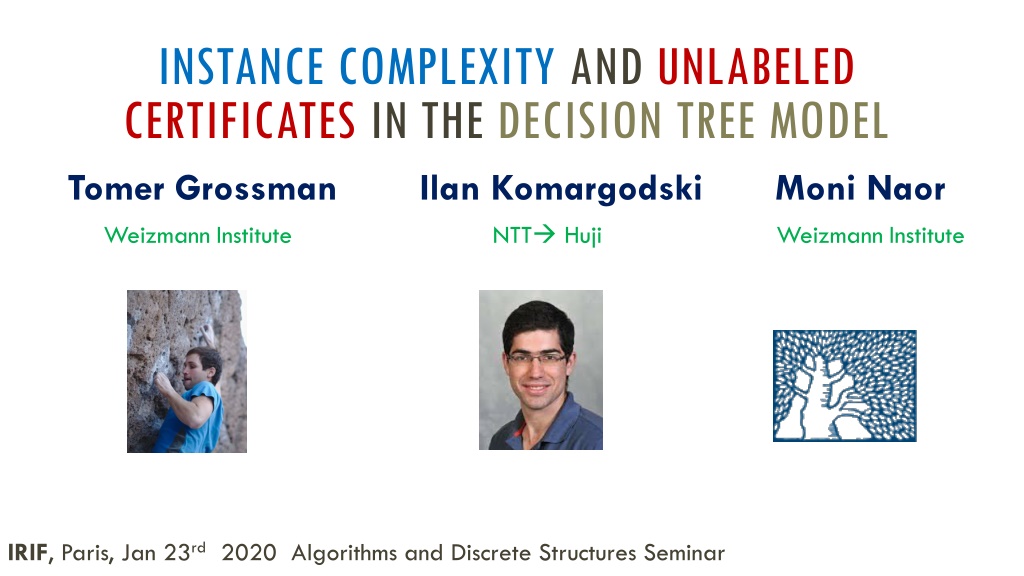
 undefined
undefined